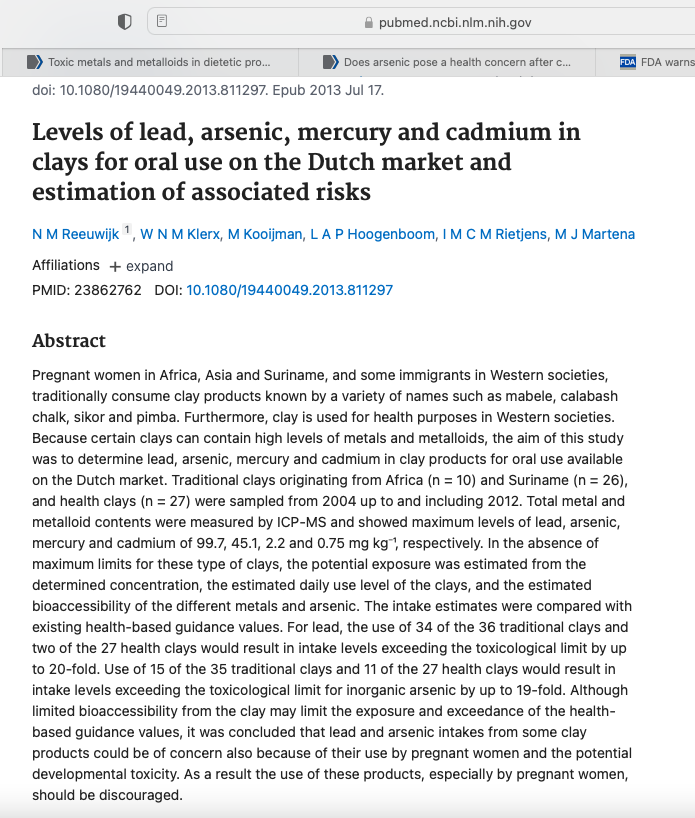Dutch Oral Use Clay Research Study: Lead, Mercury, Arsenic & Cadmium in traditional healing clays (July of 2013, NIH: National Library of Medicine)
June 21, 2022 – Tuesday
Key points
- For lead, the use of 34 of the 36 traditional clays and two of the 27 health clays would result in intake levels exceeding the toxicological limit by up to 20-fold.
- Use of 15 of the 35 traditional clays and 11 of the 27 health clays would result in intake levels exceeding the toxicological limit for inorganic arsenic by up to 19-fold.
- it was concluded that lead and arsenic intakes from some clay products could be of concern also because of their use by pregnant women and the potential developmental toxicity.
- As a result the use of these products, especially by pregnant women, should be discouraged.
The image below is also linked to the original website with this study:
Text from the image above – bold sentences are of particular relevance.
Levels of lead, arsenic, mercury and cadmium in clays for oral use on the Dutch market and estimation of associated risks
- PMID: 23862762
- DOI: 10.1080/19440049.2013.811297
Abstract
Pregnant women in Africa, Asia and Suriname, and some immigrants in Western societies, traditionally consume clay products known by a variety of names such as mabele, calabash chalk, sikor and pimba. Furthermore, clay is used for health purposes in Western societies. Because certain clays can contain high levels of metals and metalloids, the aim of this study was to determine lead, arsenic, mercury and cadmium in clay products for oral use available on the Dutch market. Traditional clays originating from Africa (n = 10) and Suriname (n = 26), and health clays (n = 27) were sampled from 2004 up to and including 2012. Total metal and metalloid contents were measured by ICP-MS and showed maximum levels of lead, arsenic, mercury and cadmium of 99.7, 45.1, 2.2 and 0.75 mg kg⁻¹, respectively. In the absence of maximum limits for these type of clays, the potential exposure was estimated from the determined concentration, the estimated daily use level of the clays, and the estimated bioaccessibility of the different metals and arsenic. The intake estimates were compared with existing health-based guidance values. For lead, the use of 34 of the 36 traditional clays and two of the 27 health clays would result in intake levels exceeding the toxicological limit by up to 20-fold. Use of 15 of the 35 traditional clays and 11 of the 27 health clays would result in intake levels exceeding the toxicological limit for inorganic arsenic by up to 19-fold. Although limited bioaccessibility from the clay may limit the exposure and exceedance of the health-based guidance values, it was concluded that lead and arsenic intakes from some clay products could be of concern also because of their use by pregnant women and the potential developmental toxicity. As a result the use of these products, especially by pregnant women, should be discouraged.
Never Miss an Important Article Again!
Join our Email List




I’m Dutch, I once ordered a clay bottle via kickstarter for alkaline water I never ended up reason because I got spooked by the thought of what might be in it… (it was clay from India at the time of the floods)
I guess warranted.
Thank you for commenting!
T
What about the clays available in this country for ingesting?
Any results on them?
stand by for some more info
This may be a really dumb question but WHY would you ingest clay?
It’s not a food, it has no nutrient value and I cannot imagine what it would do to your system once it comes into contact with the natural fluids of your body processes not to mention the liquids, water, coffee, etc that we sometimes add hourly!
I can only visualize a plumber having to come in and Jack-hammer or scraping away, or at worst having to replace your “pipes” altogether – after layers of clay have built up and blocked off the viaducts between your throat and your bowels!
If someone told me to eat dirt for any reason …… I’d tell them to get lost and to do some research from credible resources!
Love
I would say to you to take your own advice and ‘do some research from credible sources’. Clay has been used internally for healing for millennia. There are myriad ‘credible sources’ of information about the use of clay internally. You could have spent the time you used writing your comment to instead search out those sources and you would have found out the benefits of using clay internally and the history of its use.
The problem nowadays with ingesting clays is that most of our planet has been contaminated with lead from leaded gasoline, which is still used in some parts of the world, and still allowed in certain aircraft fuel.
Perhaps there are more reasons Tamara could add as to why most clay today is contaminated.
Hi,
I recently purchased some pots from Miriam Earthen Cookware and now I’m having second thoughts about it. I like the idea that it does not only doesn’t add toxins to the food, but removes it. They say the are harvesting the clay from remote areas and that they test their clay to make sure it’s non toxic and does not have heavy metals. Have you tested these pots? Is there an easy way I can test them to make sure? Thank you so much!